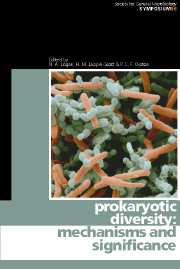Book contents
- Frontmatter
- Contents
- Contributors
- Editors' Preface
- Microbial diversity in the era of genomics
- Patterns in prokaryotic biodiversity
- A putative RNA-interference-based immune system in prokaryotes: the epitome of prokaryotic genomic diversity
- The significance of prokaryote diversity in the human gastrointestinal tract
- The genetics of phenotypic innovation
- Minimal genomes required for life
- Evolution of the core of genes
- Biogeographical diversity of archaeal viruses
- Is there a link between Chlamydia and heart disease?
- Unculturable oral bacteria
- Comparative genomics – what do such studies tell us about the emergence and spread of key pathogens?
- Spread of genomic islands between clinical and environmental strains
- Evolving gene clusters in soil bacteria
- Unusual micro-organisms from unusual habitats: hypersaline environments
- Genomic islands and evolution of catabolic pathways
- Horizontal gene transfer and its role in the emergence of new phenotypes
- Index
Editors' Preface
Published online by Cambridge University Press: 06 July 2010
- Frontmatter
- Contents
- Contributors
- Editors' Preface
- Microbial diversity in the era of genomics
- Patterns in prokaryotic biodiversity
- A putative RNA-interference-based immune system in prokaryotes: the epitome of prokaryotic genomic diversity
- The significance of prokaryote diversity in the human gastrointestinal tract
- The genetics of phenotypic innovation
- Minimal genomes required for life
- Evolution of the core of genes
- Biogeographical diversity of archaeal viruses
- Is there a link between Chlamydia and heart disease?
- Unculturable oral bacteria
- Comparative genomics – what do such studies tell us about the emergence and spread of key pathogens?
- Spread of genomic islands between clinical and environmental strains
- Evolving gene clusters in soil bacteria
- Unusual micro-organisms from unusual habitats: hypersaline environments
- Genomic islands and evolution of catabolic pathways
- Horizontal gene transfer and its role in the emergence of new phenotypes
- Index
Summary
There have been many important recent developments in our knowledge of the breadth of prokaryote diversity, our understanding of the driving forces behind that diversity, and of its significance for our lives and for fundamental processes upon Earth. It has become clear that the microbes we know about are actually just the tip of a biological iceberg. In fact, the majority of microbes are unculturable on laboratory media at present. Much of our attention has been focused on pathogens, understanding their interaction with the host and how to prevent disease. However, there is a growing appreciation that without microbes fundamental ecological processes would not be balanced. For example, microbes in the ocean have a direct influence on the composition of the atmosphere we breathe.
A major advance in allowing us to understand the extent and nature of microbial diversity has been the development of genome sequencing. In parallel, there has been the development of tools to allow whole-genome comparisons. This has facilitated the study of microbial diversity and evolution, such as allowing the tracking of unculturable organisms, the study of organisms from extreme environments, and of medical and environmental bacteria and interactions between them. It has given us insights into the exchanges of genes between organisms, resulting in an understanding of the emergence of pathogens, a process which involves both gene acquisition and gene loss. Genomic comparison has helped to identify core genes, to the point where we can predict a minimal genome needed for life, which can be supplemented by the horizontal transfer of genomic islands, phenotypic innovation and catabolic pathway evolution.
- Type
- Chapter
- Information
- Prokaryotic DiversityMechanisms and Significance, pp. xi - xiiPublisher: Cambridge University PressPrint publication year: 2006

